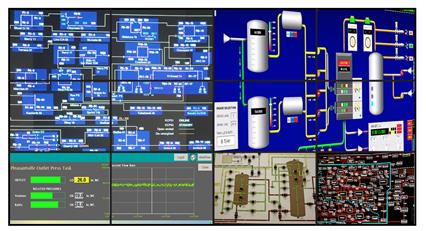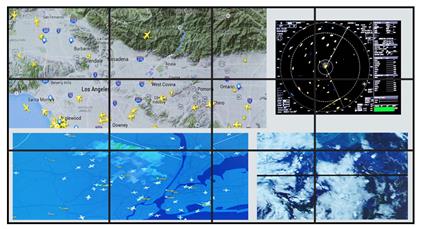The majority of control rooms have some sort of large display wall, whether a single or multiple screens, tiles, or projectors. This helps to create large-scale visualization and a common operating picture for everyone in the control room.
There are several ways to implement video walls for control rooms depending on the level of complexity and budget. The purpose of this post is a focus on the video processing aspects of the video wall, not on the display technologies. To help put different options in perspective, the following descriptions are provided for comparison.
 Basic Video Walls
Basic Video WallsThe Monitor Wall is the simplest form of video wall as it is just a collection of individual monitors. Each piece of content is limited to a single screen and cannot be scaled across multiple screens. A monitor wall can be driven by dedicated sources, or it could be front-ended with a matrix switch (AV or KVM) to switch content on the screens. Alternatively, an IP-based matrix can provide significant scale for switching the number of potential inputs in a distributed manner while avoiding a centralized matrix chassis.
 Quad-Screen Wall
Quad-Screen WallA Quad-Screen Wall is a 2x2 video wall on which a single input is scaled across all four monitors. The wall could be front-ended with a matrix switch (AV or KVM) or even just a small presentation switcher if the number of inputs is limited. Alternatively, an IP-based matrix can provide significant scale for switching the number of potential inputs in a distributed manner while avoiding a centralized matrix chassis.
 Intermediate Video Walls
Intermediate Video WallsA Multi-Window Video Wall can support content that scales across multiple screens, can be larger than a 2x2, but the content windows are limited to screen sizes. For example, with a 4x4 wall, up to four 2x2 windows could be displayed, or a 3x3 window with 7 additional single-screen windows or the entire 4x4 could be a single window. Or, there could be two 2x2 windows with eight additional single-screen windows. An IP-based matrix solution is a very easy and low-cost way to implement this type of video wall.
A Multi-View Video Wall is driven by a multi-viewer, which is a video processor that provides a limited number of pre-designed layouts for a single output. Options typically range from 4-8 windows. A multi-viewer can be used when the number of windows and scalability of a larger video wall processor is not required. A multi-viewer can also be coupled with a projector or quad-screen wall processor to increase the viewing size.
 Advanced Video Wall
Advanced Video WallBelow is a summary of several features and capabilities of the different type of video wall processors used in control rooms.
|
Basic |
Basic |
Intermediate |
Intermediate |
Advanced |
|
|
Monitor Wall |
Quad-Screen Wall |
Multi-Window Video Wall |
Multi-View Video Wall |
Advanced Video Wall |
|
|
Content Windows |
1 per screen |
One for the entire wall |
Multiple sizes, typically limited to 4x4 |
Typically 4-8 |
Only limited by practical viewing size |
|
Content Size |
Limited to single screens |
One image across all screens |
Limited to screen boundaries |
All windows on a single video output, but can feed into other wall processors. |
Windows can be freely moved and resized anywhere on the screen |
|
Window Resizing |
No |
No |
Yes, limited to screen boundaries (e.g. increase a 2x2 to 3x3) |
Yes, typically based on pre-set window layouts but PiP and Windowed views can be scaled. |
Yes. Any window can be any size. |
|
Video Input Types |
Limited. Monitor inputs type limit options unless driven by a flexible matrix switch. |
Limited. Typically a single video type such as HDMI, DVI, or DispalyPort |
Limited, but modular processors typically support multiple input types. |
Limited, but modular multi-viewers typically support multiple input types. |
Typically support all standard video types including VGA, Component, Composite, DVI, HDMI, DisplayPort, SDI, and IP. |
|
Black Box Product |
Radian |
With the range of capabilities for video wall processors, it may be difficult to distinguish which type is most appropriate for your needs. In addition, there may be some other components needed to create a complete solution. Black Box provides expert engineering support to design a solution that meets your technical and budgetary requirements. Contact our technical team today for a free, customized system design.